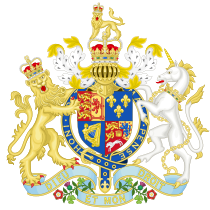The Witchcraft Act 1735 (9 Geo. II c. 5), sometimes referred to as the Witchcraft Act 1736 owing to dating complexities,[1] repealed the earlier statutes concerning witchcraft throughout Great Britain including Scotland, which had its own legal system. It reflected a change of emphasis towards the pretence of fortune telling, sorcery and witchcraft and away from their practice.[2] During the 18th century prosecutions under the new Act were rarely if ever undertaken in Scotland, as the facilities to implement the punishments laid down did not exist.[3]
The case against Jean MaxwellScottish cunning woman convicted of pretending to practise witchcraft , the Galloway sorceress, who was prosecuted and convicted under the Act in June 1805 at Kirkcudbright, is one of the first records of the statute being implemented in Scotland.[4] A cunning womanPractitioners of folk medicine, divination and thwarting witchcraft., she was sentenced to be confined in the town tollbooth for a year, the maximum allowed for. During the term of her imprisonment she was to be taken to the market place every three months and put into the jugsMetal collar formerly used as an instrument of punishment in Scotland. or pillory for an hour.[5]
The historian Malcolm Gaskill has described the conviction of Helen DuncanLast person to be imprisoned under the Witchcraft Act 1735, in 1944., a Scottish-born medium who was tried under the Act in 1944, as the “most famous and influential of a handful of prosecutions”.[6] The eight-day trial at the Old Bailey commenced on 22 March with three other people accused of the same charge. Found guilty, Helen was sentenced to nine months imprisonment while her travelling companion was incarcerated for four months and the remaining two accused were bound over. Helen was released after serving six months.[7]
Helen Duncan was the last person to be imprisoned under the Act,[8] but the medium Jane YorkeLast person to be prosecuted under the 1735 Witchcraft Act, in 1944. was the last person to be convicted under it. She was arrested on 10 July 1944, but the Director of Public Prosecutions delayed the case against her until an appeal against Helen’s judgement was heard. The appeal being unsuccessful, Jane was convicted at the Old Bailey on 12 September, but perhaps because of her age – she was seventy-two years old and disabled – she was not imprisoned but bound over for three years.[9]
The Witchcraft Act was repealed by the Fraudulent Mediums Act 1951; witchcraft was no longer a crime for the first time since 1547, when King Edward VII had repealed his father’s Act of 1542.[10][11]
See also
- Witchcraft ActsSeries of Acts passed by the Parliaments of England and Scotland making witchcraft a secular offence punishable by death.

